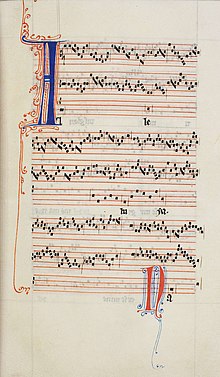
Back Modes rítmics Catalan Modalrhythmik German Ritma modalo Esperanto Modos rítmicos Spanish Modaalrütmika Estonian Modes rythmiques French Modo rítmico Portuguese Mod ritmic Romanian

In medieval music, the rhythmic modes were set patterns of long and short durations (or rhythms). The value of each note is not determined by the form of the written note (as is the case with more recent European musical notation), but rather by its position within a group of notes written as a single figure called a ligature, and by the position of the ligature relative to other ligatures. Modal notation was developed by the composers of the Notre Dame school from 1170 to 1250, replacing the even and unmeasured rhythm of early polyphony and plainchant with patterns based on the metric feet of classical poetry, and was the first step towards the development of modern mensural notation.[1] The rhythmic modes of Notre Dame Polyphony were the first coherent system of rhythmic notation developed in Western music since antiquity.
- ^ Hoppin 1978, p. 221.
© MMXXIII Rich X Search. We shall prevail. All rights reserved. Rich X Search